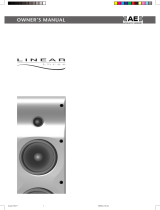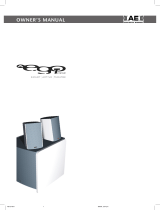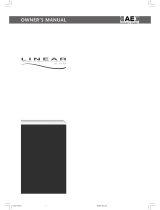Page is loading ...

OWNER’S MANUAL
Linear 1 Rev G 11/4/05, 3:46 pm1

Page Section
1 1 Introduction
1 2 Handling
1 3 Installation
2 4 Positioning
3 5 Connecting
4 6 Amplifiers
4 7 Listening
4 8 Specification
5 9 The Linear Range
5 10 Warranty
5 11 Contact Acoustic Energy
1. IntroductionContents
Linear 1 Rev G 11/4/05, 3:46 pm2

Page 1
1. Introduction
2. Handling
Welcome to the Linear One. Perhaps more than
any other hi-fi product, speakers are sensitive to
installation so please take a little time to read
this manual and to follow, as far as practical,
the installation guidelines it contains. Careful
installation will help ensure that your Linear Ones
perform optimally. Should you have any questions
not covered here we are happy to try and answer
them either by telephone or email. Contact
information can be found in Section 11.
Following this introduction, the Manual is divided
into sections covering handling, installation,
positioning, amplifier compatibility, connection,
listening, matching products, specifications,
warranty and contact information. We recommend
that you read at least the first five of these sections
carefully before installing and using your Linear
Ones.
The Linear One is a relatively delicate precision engineered product that can
be damaged by inappropriate handling. Please take care when unpacking or
moving the speakers not to touch either of the drivers. Damage to a driver
will at best degrade a Linear One’s performance and at worst result in its
complete failure.
The enclosure surfaces should also be handled sympathetically. Any cleaning
should only require a soft cloth, slightly dampened if necessary. Be wary of
using any polishes or solvent based cleaning agents.
The packaging should be retained for future use.
3. Installation
The Linear One is intended to be used mounted on speaker floor-stands
relatively clear of room boundaries. Alternative mounting arrangements
such as wall brackets are possible although these may result in reduced
performance. If wall brackets are to be used they should be as rigid as
possible and firmly attached to brick-built walls.
The construction style, rigidity and dimensions of the floor-stands are of
critical significance to the performance of the Linear One. Stands should
broadly follow the specification below. Your retailer or distributor will be able
to offer advice.
Recommended Floor-stand Specification.
Construction Style: Direct coupled multi-pillar.
Mass Loading: Preferred.
Overall height: 0.50 - 0.65 m (Linear One top panel to be just
below head height when seated).
Top plate Dimensions
Minimum width: 140 mm
Maximum width: 190 mm
Minimum depth: 190 mm
Maximum depth: 250 mm
Top plate interface: Direct coupled tri-point or damped-compliance.
Floor interface: Floor spikes (M6 minimum).
Contents
Linear 1 Rev G 11/4/05, 3:46 pm1

Page 2
4. Positioning 5. Connecting
The position of speakers within the listening room is likely to have more
influence over their performance than any other aspect of their installation.
It is worth spending some time experimenting both with the finer points of
speaker positioning, as well as the larger scale issues of room layout.
If you are already familiar with the acoustic characteristics of your listening
room, and the way speakers perform in it, you may already have a good feel
for where to position your Linear Ones. However, installing any new hi-fi
component provides a good opportunity to review an existing set-up and
perhaps make improvements.
The position requirements for a pair of Linear Ones installed in an average
sized and furnished listening room (say 4m x 5m) are as follows:
• Between 0.3 and 1.0 metres from the rear wall.
• 1.0 metres from side walls.
• Between 2.5 and 3.5 metres apart.
• Clear of corners.
• Angled inward towards the listening position.
Don’t worry if, thanks to the architecture or layout of your room, it is
not practical to follow each requirement. The most important thing is to
experiment with the different options that are practical and find the one that
works best.
While it is often the first instinct to position a pair of speakers against the
shorter wall of a rectangular room, it is often the case that a position against
the longer wall will produce better results. This is because the long wall
position tends to result in less prominent reflections from the side walls of the
room. However, whether used against the long or short wall, it is important
Diagram One
that each speaker of the pair is located in a similar
acoustic environment (different environments
would be, say, a curtained area and a solid wall).
The acoustic character of the side walls of the room
in the area where the main reflection between
speakers and listening position will occur should
also be similar. Diagram One illustrates a typical
layout.
Once your Linear Ones are connected (see Section
5) and working, and you begin to become familiar
with their performance, it is likely to be worthwhile
experimenting a little more with their positioning.
Reducing the distance between the speakers and
the rear wall will increase the level of bass and
low midrange making the speakers sound warmer.
The warmth however is likely to be gained at the
expense of some mid-range clarity and stereo image
focus and depth. Increasing the toe-in angle of the
speakers may regain some image focus but again
this is likely to be at a cost of image width and
openness. Learning through experimentation how
Linear Ones behave in your room will help you find
the optimum solution.
The Linear One is magnetically shielded and can be
used in relatively close proximity to CRT screens.
3.0 metres
angle
inward
Listening position
0.5 metres from
back wall
Reflection
region. Keep
similar each
side.
Linear 1 Rev G 11/4/05, 3:46 pm2

Page 3
4. Positioning 5. Connecting
Connecting your Linear Ones to an amplifier is
fundamentally a simple process, however, there are
some choices to be made and issues to consider
concerning connection mode, connectors and
cable type.
Each Linear One is fitted with two pairs of
binding-post terminals - one pair each for the
low frequency and high frequency drivers. Two
pairs of terminals enables Linear Ones to be
connected conventionally (single wire), bi-
wired or bi-amplified. As supplied, the high and
low frequency terminals are connected together
by metal shorting links ready for conventional
connection.
The terminals can accept either stripped wires,
spade connectors, or 4mm plugs. Each of these
termination methods is potentially equally effective
and the choice is likely to be influenced by type of
speaker cable used. Your dealer, distributor or cable
manufacturer will be able to offer advice.
Conventional [single wire] connection
Conventional connection requires that the shorting links remain in place
between the high and low frequency terminals. Simply connect the speaker
cable to either pair of terminals ensuring correct connection polarity as
described below.
Bi-Wire Connection
Bi-wiring separates the low and high frequency connections and can provide
enhanced sound quality. A second set of cables (or alternatively, a multi-way
bi-wire cable) is required. The shorting links should be removed and stored for
any subsequent single wire use.
The two cables for each speaker should be connected in parallel to the
amplifier terminals. At the speaker, one cable should connect to the high
frequency terminals and one to the low frequency terminals. Ensure correct
connection polarity as described below.
Bi-Amplifier Connection
Bi-amplifier connection adds a second power amplifier to the system so that
high and low frequency sections have dedicated amplifiers. Significantly
enhanced sound quality is possible. One stereo amplifier should be connected
to the high frequency terminals of each speaker and a second stereo amplifier
connected to the low frequency terminals. The shorting links should be
removed and stored for any subsequent single wire use. Ensure correct
connection polarity as described below. Follow the amplifier manufacturer’s
guidence on connecting the amplifier input signals.
The shorting links must be removed for bi-amplifier connection. Failure
to do so will likely result in damage to the amplifiers.
Connection Polarity
It is important when connecting speakers to ensure that each terminal is
connected with the correct polarity. Positive speaker terminals should always
be connected back to amplifier positive terminals, and negative speaker
terminals connected back to amplifier negative terminals. Performance will be
seriously degraded if connections are made with incorrect polarity.
Take care when connecting cables not to touch the negative and positive
terminals together and “short-circuit” the amplifier. Make connections with
the amplifier switched off.
Choice of cable type will be influenced by the characteristics of other
components in your hi-fi system and your dealer or distributor will be able to
advise. Even so, there are some simple guidelines to consider:
• Cable runs to each speaker should be kept as short as possible
consistent with each being of equal length.
• Short cable runs are especially important if the cable is of relatively small
cross-sectional-area.
• If the cable is advertised as “directional” care should be
taken to ensure that its orientation is as recommended.
Linear 1 Rev G 11/4/05, 3:46 pm3

Page 4Page 4
6. Amplifiers 9. The Linear Range
It is wise before listening to your Linear Ones to make one final check of the
cables and connections. If all appears well begin listening at a relatively low
level to confirm that the system is operating as expected. Only increase the
volume if you are happy that the sound at low levels is fundamentally as
expected. If you are unhappy, turn the system off and re-check all the cables
and connections.
Linear Ones may take a little time to “run-in”, and similarly the system will
also perhaps take some time to reach normal operating temperatures. It is
unwise therefore to make rapid judgements about the performance of the
speakers. Your ears too will take some time to adjust to the new sound, so
revisiting the system set-up, speaker positioning especially, is best left for a
few days.
7. Listening
8. Specification
Type: Two-way, reflex loaded, time aligned
speaker.
Bass/Mid Driver: 130mm pressed alloy cone with
32mm thermally bonded voice coil. Shielded high-
power long-throw magnet system.
HF Driver: Pre-coated textile dome with ferro-fluid
cooled neodymium magnet system.
Filter Network: Symmetrical 3rd order at 3.5kHz.
Cabinet: 15mm MDF carcass with composite layer
front panel and driver de-coupling.
Frequency Response: 50Hz to 28kHz ±3dB
Frequency Range: 30Hz to 28kHz @ -6dB
Power Handling: 120W peak programme
Amplifier Compatibility: 25 - 120 Watts into 8
Ohms
Nominal Impedance: 8 Ohms
Sensitivity: 89dB for 1 Watt at 1 metre
Dimensions (H x W x D): 363 x 192 x 260mm
Weight: 7 kg (single, unpacked)
Acoustic Energy reserves the right to modify
product specifications.
The Linear One is a relatively high sensitivity speaker that does not require a
generously rated power amplifier for adequate volume levels to be achieved
in an average listening room. A minimum of 25 and maximum of 120 Watts
into 8 Ohms per channel is recommended. Linear Ones offer a relatively easy
load to the amplifier and do not make unusually heavy demands on its power
delivery.
No overload protection systems are fitted to the Linear One so it is possible
to cause damage through over-driving. Such damage can occur whatever
the power rating of the amplifier and is not covered by any warranty. If ever
the sound at high volumes becomes distorted your Linear Ones are at risk of
damage. In such circumstances the volume must be reduced.
Linear 1 Rev G 11/4/05, 3:47 pm4

Page 5
6. Amplifiers 9. The Linear Range
8. Specification
10. Warranty
11. Contact
The Linear One is part of a range that includes
the Linear Three floor-stand speaker, the Linear
Centre centre channel speaker and the Linear Sub
active sub-woofer.
Linear One, Linear Three and Linear Centre
incorporate time-aligned drivers to improve image
quality, depth and focus.
Linear Three
Linear Three is a true three-way floor stand speaker
that builds on the performance of the Linear One
with wider bandwidth, higher power handling and
enhanced detail resolution.
Linear Centre
Linear Centre is a centre channel speaker designed
to combine with the Linear One or Three for
perfectly matched audio-visual systems.
Linear Sub
Linear Sub is an active sub-woofer perfect for
enhancing Linear One bass performance or
handling the low frequency effects channel in
Linear audio-visual systems.
Your Acoustic Energy speakers are guaranteed against original defects in
materials, manufacture and workmanship for 3 years from the date of
purchase.
Under this warranty Acoustic Energy agrees to repair any defect or, at the
company’s discretion, replace the faulty component(s) without charge for
parts or labour. This warranty does not imply any acceptance by Acoustic
Energy or its agents for consequential loss or damage and specifically
excludes fair wear and tear, accident, misuse or unauthorised modification.
This warranty is applicable in the United Kingdom only and does not in any
way limit the customer’s legal rights. Claims and enquiries under the warranty
for Acoustic Energy products purchased outside the UK should be addressed
to the local importers or distributors. If you have reason to claim under the
warranty please contact your dealer in the first instance.
Please retain all original packaging materials for possible future use. We
suggest that you complete details of purchase now and keep this information
in a safe place for future reference.
Name:
Address:
Dealer:
Purchase Date:
Serial Numbers:
Acoustic Energy Limited
16 Bridge Road
Cirencester
Gloucestershire GL7 1NJ
UK
Tel: +44 (0)1285 654432 (Sales)
+44 (0)1285 656890 (Technical)
Fax: +44 (0)1285 654430
Email: [email protected]
Web: www.acoustic-energy.co.uk
Linear 1 Rev G 11/4/05, 3:47 pm5

Acoustic Energy Limited, 16 Bridge Road, Cirencester, Gloucestershire GL7 1NJ.
Tel: +44 (0)1285 654432 (Sales), +44 (0)1285 656890 (Technical). Fax: +44 (0)1285 654430
Email: info@acoustic-energy.co.uk
Web: www.acoustic-energy.co.uk
Manual Part No. MA1101
Linear 1 Rev G 11/4/05, 3:47 pm6
/








